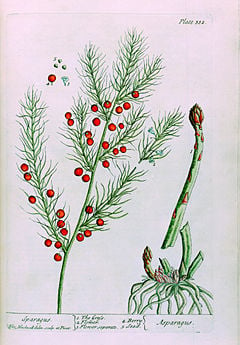Some University of Illinois Extension Classes offered in March, April and May. Enlarge to read and print the registration form. Always a good time and lots of interesting garden information.
I've never understood why every family with a small plot of soil hasn't planted asparagus. OK, I do understand because I just planted some hybrid asparagus last year. Up until then I simply cut the plants in our back woods. Not sure if they were planted years ago by some farm wife or if they are wild. At any rate, they gave me a good taste but not even close to enough for an asparagus lover like me.
This old botanical print shows all parts of the asparagus plant. The young tender spring shoots are what we know as our dining asparagus. White asparagus has had the sunlight blocked. There is purple asparagus that is reported more tender and sweet.
Asparagus officinalis is a spring perennial. It is native to Europe, N. Africa and W. Asia. One of the oldest recorded vegetables reportedly is a picture surviving from 3000 BC.
The asparagus companion plant is the tomato because it helps repel asparagus beetles.
The US states that have commercial asparagus crop production are Washington, California and Michigan.
Now, for the question everyone wants to ask but polite company does not: "Why does urine smell after eating asparagus?" Certain compounds in asparagus are metabolized, giving urine a distinctive smell due to various sulfur-containing degradation products, including various thiols, thioesters, and ammonia. The organic compounds responsible are: methanethiol, dimethyl sulfide, dimethyl disulfide, bis(methylthio), methane, dimethyl sulfoxide, and dimethyl sulfone. Everyone that eats asparagus has urine that smells like this but only 22% of those people can smell it. Thank you S. C. Mitchell for "Food idiosyncrasies: beetroot and asparagus". What would you do without my help on Trivia Night?
I planted my new asparagus at the side of my garden bed. My garden is on the upside of a small hill. The Michigan Asparagus Advisory Board recommends, "Choose a sandy, well-drained spot in full sun. Asparagus does not tolerate saturated soil conditions, so if you have clay soil, choose a hilltop or hillside. If water stands in the spot you have chosen for only an hour, it is probably too wet for asparagus." Read their many recommendations and other information at http://www.asparagus.org/
Don't harvest your new asparagus the year it is planted and not the next year. On the third year, take a few cuttings. On the forth year, harvest when the spears are 11-15 inches tall and again as new growth reaches the same height. If you have a large area of plants, it may be harvested every day. When the plants stop producing many spears, stop picking for the season to let the crown recuperate.
Asparagus sets or crowns may be found at most full nurseries, on line or in catalogs. Plant exactly per directions.
More trivia from the fine folks in Michigan: "Growers should harvest all of the spears that come up until the end of the harvest period, even the small diameter ones we call "whips". You will find that whips are generally higher in fiber and tougher to eat than large diameter spears. That is because most of the fiber in asparagus is in the skins, making the larger spear the more tender. This is the exact opposite of what consumers assume when buying fresh asparagus, but is true nevertheless."
It is suggested you snap off the spears instead of cutting. In this way you will only have tender shoots. Don't use salt to keep weeds away. It works if you use enough but it also damages the soil around it for other plants pretty much forever - plus it may run-off in the rain to other plants and it turns clay soil into a concrete like texture. Not good. I prefer to hand weed and mulch since hoeing may damage the crowns. Remove all debris near the plants as this is a breeding area for disease. Should you have insect or disease problems, consult and research prior to buying.
In the Midwest, asparagus (once established) does not need watering because the roots can grow to 10 foot down. Fertilizer is not necessary unless the soil, in general, is lacking in a balanced ratio. Do not prune off the feathery ferns or the berries - both are needed to build nutrients for next year's produce.
The good news: Asparagus is a nutrient-dense food which in high in Folic Acid and is a good source of potassium, fiber, vitamin B6, vitamins A and C, and thiamin. Asparagus has no fat, contains no cholesterol and is low in sodium. It's truly beautiful, nutritious and delicious!
Added from my friend Pat R.: Asparagus Wraps
20 fresh asp. spears
1 loaf thin bread slices
8 oz. cream cheese
1/4 c. blue cheese crumbles
1 - Egg - slightly beaten
3/4 lbs butter (yes this is correct)
Cut crusts off bread. Combine egg and cheeses & spread on 20 slices of bread. Lay one asparagus on each and wrap bread around. Seal with a toothpick. Freeze for one hour. Melt butter, roll spears in it, remove picks and bake 25 min. at 400 degrees.




No comments:
Post a Comment